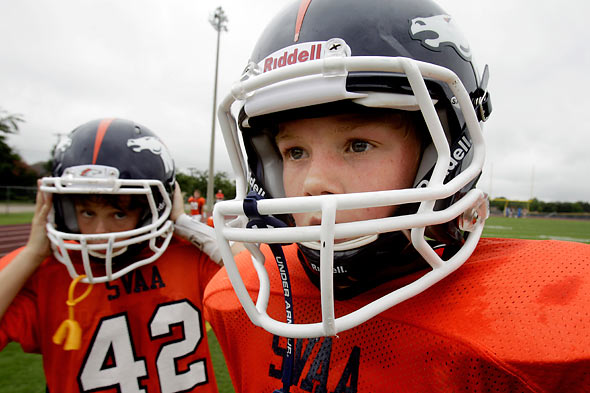 No hiding it: Concussions and their long-term effects are in the spotlight. Although they’ve been a concern for sport’s governing bodies since 1933, with the high-profile NFL settlement and todays sue-first culture… the topic can no longer be disregarded.
No hiding it: Concussions and their long-term effects are in the spotlight. Although they’ve been a concern for sport’s governing bodies since 1933, with the high-profile NFL settlement and todays sue-first culture… the topic can no longer be disregarded.
We’re learning more everyday about the effects of the injury on the brain, including Chronic Traumatic Encephalopathy (CTE), but there’s still much work to be done. The complexity of the human brain is one of science’s final frontiers; along with the deepest depths of the ocean and the farthest reaches of space. So, we find ourselves engaged in great debate as science slowly discovers new details, where parents and caregivers are demanding new strategies and safeguards.
In just five years all 50 states passed legislation regarding head injuries, making it one of the fastest adopted policies in US history. Not since the institution of seatbelt laws, has public safety been so uniformly agreed upon. This legislation has set guidelines for administrators to create safer environments, but is often unfunded and leaves out enforcement stipulations.
In addition to state and federal policy, state policies continue to educate athletes about the latest, most effective practices for lowering concussion risk, targeting the millions of children playing contact sports each year.
Naturally, there are many questions and much uncertainty over what ultimately influences concussion rates. Is it tackling technique? Is neck strength a culprit? Is age a factor? Do helmet types make a difference?
On this last question, we have some clarity. Helmets don’t prevent concussions. Moreover, in some cases they can be the cause of head injuries! An improperly fitted helmet increases the risk for concussions. Think about how ineffective and dangerous cleats would be if they weren’t laced. It’s the same concept for helmet fitting.
In a case study performed at a single high school, an athletic trainer (using the InjureFree reporting platform) recorded injuries within the freshman, junior varsity and varsity football teams. During the first three weeks of practice, eight (8) concussions were reported, within a population of 150 athletes, drawing the attention of team administrators.
Using the aggregated data, it was identified that all eight concussions were sustained using parent-bought helmets, rather than school-issued. While the public-school district supplied all necessary equipment, parents were given the choice to purchase their own helmets; similar to most schools throughout the US. This discovery provided valuable information to district officials who feared for the safety of student athletes and the possibility of a lawsuit.
Recent lawsuits and extensive media attention about concussions, likely caused parents to react by purchasing “top-rated” football helmets for their children. While these proactive attempts to protect children are commendable, in this case the sporting goods store helmets were not properly fitted. There are no policies requiring salespeople to be trained to properly fit helmets, so these eight students ended up playing with poorly fitted equipment.
After identifying a potential catalyst for concussion “epidemic”, an email alert was triggered by InjureFree to the parents of football players at that school, notifying them to “see the athletic trainer if your son is not using a school issued helmet,” and fitting adjustments were made. During the remaining 12 weeks of the football season only three concussions were reported, all during game play.
This case study is a terrific reminder for all athletes to check for proper fitting of equipment every time they suit up. We don’t drive on flat tires and we don’t fly with icy airplane wings. So why would be we allow athletes to play without ensuring all protective equipment is working properly?
InjureFree is a mobile injury reporting platform that helps coaches, parents and care-givers document injuries in real-time. To learn more or demo the product, please visit their website.
Charlie Wund (@charliewund) is the President of the Agency for Student Health Research, a company dedicated to achieving the healthiest possible environment for all children. Charlie participated in in the 2014 International Olympic Committee Conference on Illness and Injury in Sport, testified before the New York City Council, and presents at technology summits focused on mobile health applications; all with the goal of providing the best possible care for children as they participate in school and youth sports.
The Agency for Student Health Research works with educational institutions, athletic organizations, and community health groups to increase children’s opportunity for success, focusing on health promotion and injury prevention. For more information, please visit www.InjureFree.com or schedule a personal online demonstration of the platform HERE.

